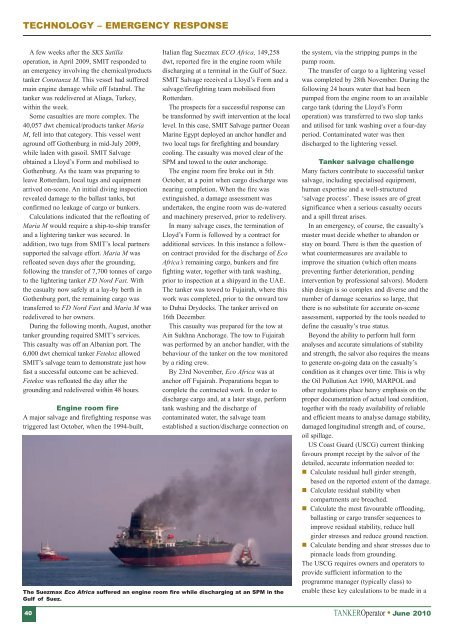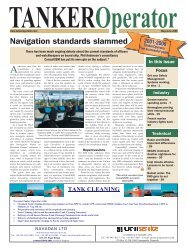Features: - Tanker Operator
Features: - Tanker Operator
Features: - Tanker Operator
You also want an ePaper? Increase the reach of your titles
YUMPU automatically turns print PDFs into web optimized ePapers that Google loves.
TECHNOLOGY – EMERGENCY RESPONSE<br />
A few weeks after the SKS Satilla<br />
operation, in April 2009, SMIT responded to<br />
an emergency involving the chemical/products<br />
tanker Constanza M. This vessel had suffered<br />
main engine damage while off Istanbul. The<br />
tanker was redelivered at Aliaga, Turkey,<br />
within the week.<br />
Some casualties are more complex. The<br />
40,057 dwt chemical/products tanker Maria<br />
M, fell into that category. This vessel went<br />
aground off Gothenburg in mid-July 2009,<br />
while laden with gasoil. SMIT Salvage<br />
obtained a Lloyd’s Form and mobilised to<br />
Gothenburg. As the team was preparing to<br />
leave Rotterdam, local tugs and equipment<br />
arrived on-scene. An initial diving inspection<br />
revealed damage to the ballast tanks, but<br />
confirmed no leakage of cargo or bunkers.<br />
Calculations indicated that the refloating of<br />
Maria M would require a ship-to-ship transfer<br />
and a lightering tanker was secured. In<br />
addition, two tugs from SMIT’s local partners<br />
supported the salvage effort. Maria M was<br />
refloated seven days after the grounding,<br />
following the transfer of 7,700 tonnes of cargo<br />
to the lightering tanker FD ord Fast. With<br />
the casualty now safely at a lay-by berth in<br />
Gothenburg port, the remaining cargo was<br />
transferred to FD ord Fast and Maria M was<br />
redelivered to her owners.<br />
During the following month, August, another<br />
tanker grounding required SMIT’s services.<br />
This casualty was off an Albanian port. The<br />
6,000 dwt chemical tanker Fetekoz allowed<br />
SMIT’s salvage team to demonstrate just how<br />
fast a successful outcome can be achieved.<br />
Fetekoz was refloated the day after the<br />
grounding and redelivered within 48 hours.<br />
Engine room fire<br />
A major salvage and firefighting response was<br />
triggered last October, when the 1994-built,<br />
Italian flag Suezmax ECO Africa, 149,258<br />
dwt, reported fire in the engine room while<br />
discharging at a terminal in the Gulf of Suez.<br />
SMIT Salvage received a Lloyd’s Form and a<br />
salvage/firefighting team mobilised from<br />
Rotterdam.<br />
The prospects for a successful response can<br />
be transformed by swift intervention at the local<br />
level. In this case, SMIT Salvage partner Ocean<br />
Marine Egypt deployed an anchor handler and<br />
two local tugs for firefighting and boundary<br />
cooling. The casualty was moved clear of the<br />
SPM and towed to the outer anchorage.<br />
The engine room fire broke out in 5th<br />
October, at a point when cargo discharge was<br />
nearing completion. When the fire was<br />
extinguished, a damage assessment was<br />
undertaken, the engine room was de-watered<br />
and machinery preserved, prior to redelivery.<br />
In many salvage cases, the termination of<br />
Lloyd’s Form is followed by a contract for<br />
additional services. In this instance a followon<br />
contract provided for the discharge of Eco<br />
Africa’s remaining cargo, bunkers and fire<br />
fighting water, together with tank washing,<br />
prior to inspection at a shipyard in the UAE.<br />
The tanker was towed to Fujairah, where this<br />
work was completed, prior to the onward tow<br />
to Dubai Drydocks. The tanker arrived on<br />
16th December.<br />
This casualty was prepared for the tow at<br />
Ain Sukhna Anchorage. The tow to Fujairah<br />
was performed by an anchor handler, with the<br />
behaviour of the tanker on the tow monitored<br />
by a riding crew.<br />
By 23rd November, Eco Africa was at<br />
anchor off Fujairah. Preparations began to<br />
complete the contracted work. In order to<br />
discharge cargo and, at a later stage, perform<br />
tank washing and the discharge of<br />
contaminated water, the salvage team<br />
established a suction/discharge connection on<br />
The Suezmax Eco Africa suffered an engine room fire while discharging at an SPM in the<br />
Gulf of Suez.<br />
40<br />
the system, via the stripping pumps in the<br />
pump room.<br />
The transfer of cargo to a lightering vessel<br />
was completed by 28th November. During the<br />
following 24 hours water that had been<br />
pumped from the engine room to an available<br />
cargo tank (during the Lloyd’s Form<br />
operation) was transferred to two slop tanks<br />
and utilised for tank washing over a four-day<br />
period. Contaminated water was then<br />
discharged to the lightering vessel.<br />
<strong>Tanker</strong> salvage challenge<br />
Many factors contribute to successful tanker<br />
salvage, including specialised equipment,<br />
human expertise and a well-structured<br />
‘salvage process’. These issues are of great<br />
significance when a serious casualty occurs<br />
and a spill threat arises.<br />
In an emergency, of course, the casualty’s<br />
master must decide whether to abandon or<br />
stay on board. There is then the question of<br />
what countermeasures are available to<br />
improve the situation (which often means<br />
preventing further deterioration, pending<br />
intervention by professional salvors). Modern<br />
ship design is so complex and diverse and the<br />
number of damage scenarios so large, that<br />
there is no substitute for accurate on-scene<br />
assessment, supported by the tools needed to<br />
define the casualty’s true status.<br />
Beyond the ability to perform hull form<br />
analyses and accurate simulations of stability<br />
and strength, the salvor also requires the means<br />
to generate on-going data on the casualty’s<br />
condition as it changes over time. This is why<br />
the Oil Pollution Act 1990, MARPOL and<br />
other regulations place heavy emphasis on the<br />
proper documentation of actual load condition,<br />
together with the ready availability of reliable<br />
and efficient means to analyse damage stability,<br />
damaged longitudinal strength and, of course,<br />
oil spillage.<br />
US Coast Guard (USCG) current thinking<br />
favours prompt receipt by the salvor of the<br />
detailed, accurate information needed to:<br />
Calculate residual hull girder strength,<br />
based on the reported extent of the damage.<br />
Calculate residual stability when<br />
compartments are breached.<br />
Calculate the most favourable offloading,<br />
ballasting or cargo transfer sequences to<br />
improve residual stability, reduce hull<br />
girder stresses and reduce ground reaction.<br />
Calculate bending and shear stresses due to<br />
pinnacle loads from grounding.<br />
The USCG requires owners and operators to<br />
provide sufficient information to the<br />
programme manager (typically class) to<br />
enable these key calculations to be made in a<br />
TANKER<strong>Operator</strong> June 2010
















